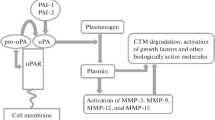Abstract
Plasminogen activators (PAs) play an important role in tumor cell invasion. We have analysed the expression of tissue-type PA (t-PA), urokinase-type PA (u-PA), and their respective receptors, annexin II and u-PAR, in normal and neoplastic cultures of pancreatic cells, as well as in pancreatic tissues, and have examined their role in tumor invasiveness in vitro. Using Northern blotting, Western blotting, and ELISA, t-PA is detected in cultured pancreas cancer cells displaying a well differentiated phenotype but it is undetectable in less differentiated cells and in normal pancreatic cultures. In contrast, u-PA transcripts, protein, and enzymatic activity are detected both in cancer cells and in normal cultures. Higher levels of u-PAR and annexin II are present in cancer cells than in normal cultures and, in SK-PC-1 cells, both receptors are localized in the basolateral membrane. In vitro invasion assays indicate that both t-PA and u-PA contribute to the invasiveness of SK-PC-1 cells through reconstituted extracellular matrix. To determine the relevance of these studies to pancreas cancer, immunohistochemical assays have been used to examine the expression of t-PA, u-PA, and their receptors in normal and neoplastic tissues. t-PA is absent from normal pancreas and from tumor associated pancreatitis, whereas it is detected in the majority of pancreas cancer tissues (16/17). Annexin II is also overexpressed in some tumors (5/13). u-PAR is overexpressed in most tumor samples examined (14/15), while u-PA is weakly detected in a low number of cases (3/14); both u-PAR and u-PA are overexpressed in areas of tumor associated pancreatitis. Indirect evidences indicate that K-ras and p53 mutated proteins can regulate the expression of PAs. In pancreatic cancer we have found an association between codon 12 K-ras mutations and t-PA expression (P=0.04). These results support the contention that, in the exocrine pancreas, activation of t-PA is more specifically associated to neoplastic transformation and to the invasive phenotype, whereas the induction of u-PA/u-PAR system might be more relevant to inflammatory or non-neoplastic events.
Similar content being viewed by others
Author information
Authors and Affiliations
Rights and permissions
About this article
Cite this article
Paciucci, R., Torà, M., Díaz, V. et al. The plasminogen activator system in pancreas cancer: role of t-PA in the invasive potential in vitro. Oncogene 16, 625–633 (1998). https://doi.org/10.1038/sj.onc.1201564
Received:
Revised:
Accepted:
Published:
Issue Date:
DOI: https://doi.org/10.1038/sj.onc.1201564
- Springer Nature Limited
Keywords
This article is cited by
-
CPEB4 interacts with Vimentin and involves in progressive features and poor prognosis of patients with astrocytic tumors
Tumor Biology (2016)
-
Serum annexin A2 levels in acute brucellosis and brucellar spondylodiscitis
European Journal of Clinical Microbiology & Infectious Diseases (2014)
-
Three are better than one: plasminogen receptors as cancer theranostic targets
Experimental Hematology & Oncology (2013)
-
Key contribution of CPEB4-mediated translational control to cancer progression
Nature Medicine (2012)
-
The Role of Annexin A2 in Tumorigenesis and Cancer Progression
Cancer Microenvironment (2011)




